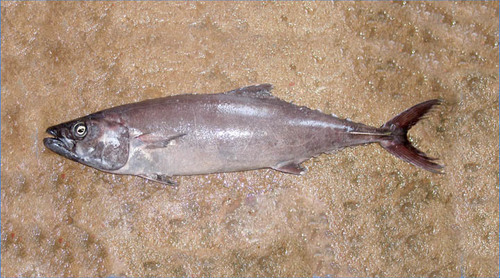
Escolar
The Atlantic bluefin tuna (Thunnus thynnus) is a highly migratory, large pelagic fish renowned for its size, speed, and commercial value. This powerful predator plays a crucial role in the marine ecosystem, with a life history adapted to long-distance travel and efficient hunting. Sadly, its desirability has led to severe overfishing.
9 12 years
Lifespan
200 cm
Length
Least Concern
Conservation Status
35 km/h
Swimming speed
Carnivorous
Diet
Local Migration
Migration
Appearance Overview
The Atlantic bluefin tuna is a large, streamlined fish with a metallic blue body and a silvery underside.
Coloration
Dark metallic blue on top, silvery underside
Body Shape
Torpedo-shaped, built for speed and endurance
Fins
Two dorsal fins, the first depressible; small finlets running down the back and belly
Size
One of the largest bony fish species
Length
Up to 13 feet (4 meters), commonly around 6.5 feet (2 meters)
Weight
Up to 2,000 lbs (907 kg), commonly around 550 lbs (250 kg)
Diet
Carnivorous, feeding on a variety of fish (such as herring, mackerel, and hake), squid, eels, and crustaceans.
Feeding Behavior
Highly active predator, using its speed and agility to hunt. They can dive to significant depths and often hunt cooperatively, herding prey.
Social Behavior
Forms large schools, especially when young. Schools can be mixed with other tuna species. Migratory, traveling vast distances across oceans.
Commercial Relevance
Extremely high value, particularly in the sushi and sashimi markets. Overfishing has significantly impacted its economic availability.
Conservation measures
Subject to international fishing quotas and regulations (e.g., ICCAT). Marine protected areas and efforts to reduce bycatch are also in place.
Status
Endangered (IUCN)
Threats
Overfishing (historically and continuing), bycatch in fishing gear, climate change affecting prey distribution and spawning grounds.
Habitat Distribution
Depth Range
0-3,300 feet (0-1,000 meters), but commonly found in shallower waters.
Geographic Range
Western and Eastern Atlantic Ocean, including the Mediterranean Sea. Migratory routes cover vast areas.
Preferred Environment
Pelagic, open ocean environments. Prefers temperate and subtropical waters.
Reproduction and Life Cycle
Breeding Habits
Spawns in warm waters, with two main spawning grounds: the Mediterranean Sea and the Gulf of Mexico. Spawning typically occurs in spring and summer.
Development Stages
Eggs are pelagic, floating freely in the water. Larvae are planktonic, feeding and growing rapidly. Juveniles form schools and gradually mature.
Fecundity
Highly fecund; a single female can release up to 30 million eggs per spawning season.
Maturity Age
Reaches sexual maturity at around 4-8 years, though this can vary depending on location and population.
Faqs about Escolar
How long do Atlantic bluefin tuna live?
Atlantic bluefin tuna can live up to 40 years, though this is becoming rarer due to fishing pressure.
Where are Atlantic bluefin tuna found?
They are found in the Atlantic Ocean, from the Mediterranean Sea to the Gulf of Mexico, and from Newfoundland to Brazil.
Are bluefin tuna warm-blooded?
Yes, they are warm-blooded, maintaining a body temperature higher than the surrounding water, which aids in their speed and endurance.
What is the biggest threat to Atlantic Bluefin Tuna?
They are primarily threatened by overfishing, which has severely depleted their populations.
How fast can Atlantic bluefin tuna swim?
Atlantic bluefin tuna are among the fastest fish in the ocean, capable of swimming at speeds up to 43 mph (70 km/h).
Copyright @ Nature Style Limited. All Rights Reserved.
 English
English